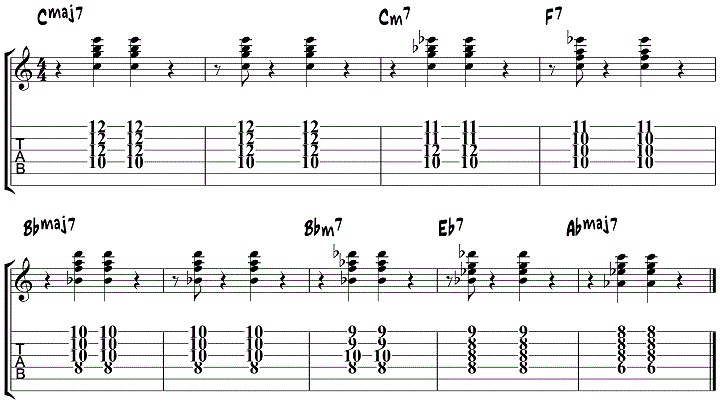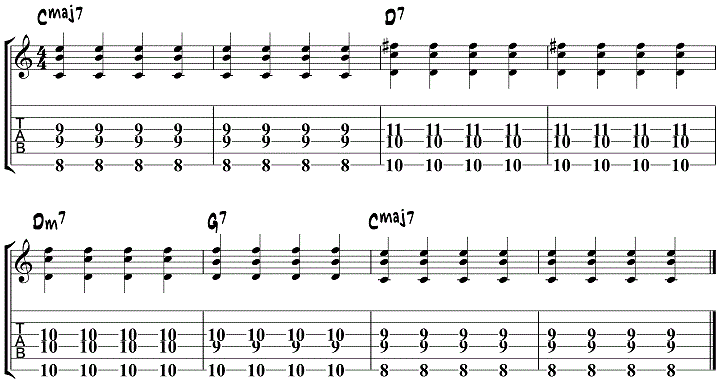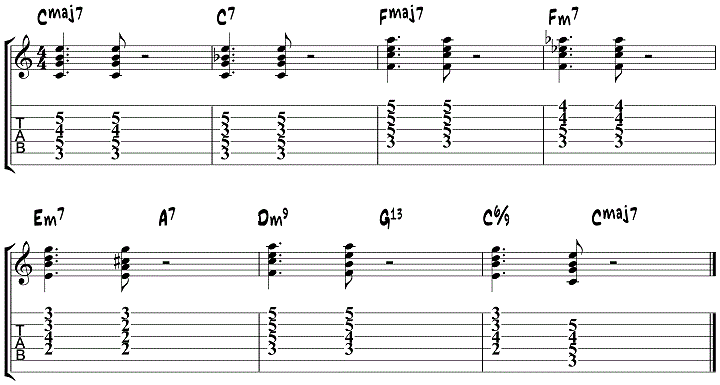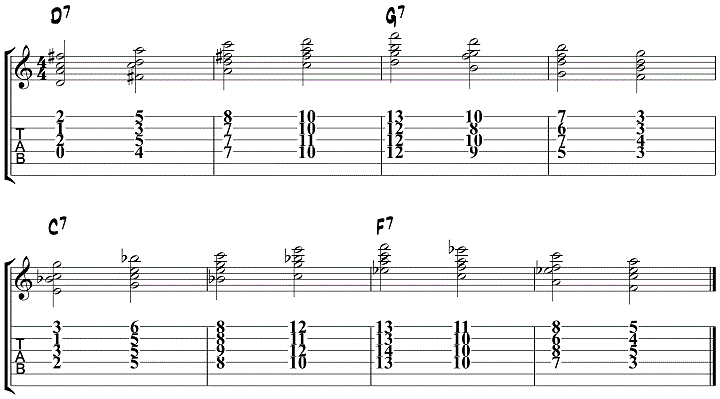Chord progressions are a succession of chords played one after another and during a specified duration. On this page, you’ll find the 10 most popular chord progressions in jazz, a list of songs that use similar chord progressions and the jazz guitarists who recorded these songs.
In this lesson you will learn how to recognize these progressions from a Roman Numeral standpoint, allowing you to quickly transpose them to other keys, as well as two different ways to comp through each progression on the guitar.
It’s important that you learn to recognize these classic chord progressions and that you practice improvising over them, so grab your axe, turn up your amp and let’s dig into these 10 Must Know Jazz Guitar Chord Progressions!
Jazz Guitar Chord Progression 1 – ii V I Major
| iim7 | V7 | Imaj7 | % |
| Dm7 | G7 | Cmaj7 | % |
The 2 5 1 progression is without any doubt the most popular chord progression in jazz. I’m not going to give you a list of songs that use this progression, since a jazz standard without a II V I is almost unthinkable. Some jazz standard chord progressions are nothing more then a series of II Vs.
It can be found in countless tunes, in all 12 keys, and with many different permutations, both rhythmically and harmonically. For this reason, it is the best place to start when working on solidifying and expanding your jazz guitar progressions repertoire.
Btw, the % symbol means you have to repeat the chord of the previous bar.
Here are two examples of how to play this progression in the key of C:


Jazz Guitar Chord Progressions 2 – Rhythm Changes
| Imaj7 vim7 | iim7 V7 | iiim7 VI7 | iim7 V7 |
| Cmaj7 Am7 | Dm7 G7 | Em7 A7 | Dm7 G7 |
This chord progression is the first A of a Rhythm Changes. ‘Rhythm changes’ are a kind of chord progression that use the same chord changes as ‘I’ve Got Rhythm‘, a song written by Gershwin in 1930. People started using this progression to jam on and so many different melodies came into being that use the same chord changes.
A list of standards that use this progression:
| Song Title | Played By |
| Moose the Mooche | Pat Metheny |
| Shaw Nuff | Barney Kessel |
| Cheek to Cheek | George Van Eps |
| Mean to Me | Barney Kessel |
| Isn’t It Romantic | Tal Farlow |
| Long Ago and Far Away | Earl Klugh |
Built around the I-vi-ii-V progression, with a slight variation between the first and second two-bar phrases, this chord progression can be deceptively simple, which is why a lot of guitarists don’t dig deep when exploring this progression. But, for those that do lift the hood and explore these changes with a bit more detail, you can learn new and creative ways of outlining these oft-used chords, taking your Rhythm Changes comping to new levels of creativity at the same time.
Here are two examples of how to comp through these changes to help get you started:


Jazz Guitar Chord Progressions 3 – Descending ii V I
| Imaj7 | % | (iim7 | V7) |
| Cmaj7 | % | Cm7 | F7 |
| Imaj7 | % | (iim7 | V7) |
| Bbmaj7 | % | Bbm7 | Eb7 |
| Imaj7 |
| Abmaj7 |
This is also a very common jazz chord progression. Used in tunes such as “How High the Moon” and “Tune Up,” descending major ii V I’s are a commonly used harmonic device that can prove to be kind of tricky when first learning to navigate these chords.
There are 2 modulations in this progression:
- The chords start in the key of C major.
- They modulate to Bb major in the 3rd bar.
- They modulate again in the 7th bar, this time to Ab major.
| Song Title | Played By |
| How High the Moon | Joe Pass |
| Tune Up | Wes Montgomery |
| Cherokee | Tal Farlow |
| Joy Spring | Joe Pass |
| One Note Samba | Charlie Byrd |
| Solar | Pat Metheny |
When faced with descending harmonic patterns such as this, many of us simply repeat the same chords down two frets for each new key. While this can work, more advanced players will find ways to ascend up the neck as the chord progression descends, providing a nice harmonic contrast during these chords.
Here are two examples of how you could practice comping through these changes:


Jazz Guitar Chord Progressions 4 – Dim7 Passing Chords
| Imaj7 #I°7 | iim7 #II°7 | iiim7 VI7 |
| Cmaj7 C#°7 | Dm7 D#°7 | Em7 A7 |
Heard in tunes such as “Cherokee,” the use of Dim7 passing tones to connect the Imaj7 and iim7 chords, as well as the iim7 and iiim7 chords, in any chord progression are a commonly used and important harmonic device that can spice up the playing of any jazz guitarist.
Dim7 chords not only add harmonic tension to this progression, but the chromatic bass line helps to build tension, which is then resolved to the iim7 and iiim7 chords in the following downbeats.
| Song Title | Played By |
| Cherokee | Tal Farlow |
| Have You Met Miss Jones | Kenny Burrell |
| Joy Spring | Joe Pass |
| But Beautiful | Lenny Breau |
| Ain’t Misbehavin’ | Django Reinhardt |
To get you started, here are two ways that you could work on comping these important chords in your practice routine:


Jazz Guitar Chord Progressions 5 – Take the A Train
| Imaj7 | % | II7 | % |
| Cmaj7 | % | D7 | % |
| iim7 | V7 | Imaj7 | % |
| Dm7 | G7 | Cmaj7 | % |
These chords, which feature the cool-sounding and fun to play II7 chord, are mostly associated with the classic Ellington track “Take the A Train.”
The movement from Imaj7 to II7 to iim7 is one that you will see in many different jazz guitar tunes, including the classic Bossa Nova track “Girl From Ipanema,” and is therefore worth working on from both a comping and blowing standpoint.
| Song Title | Played By |
| Take the ‘A’ Train | George Benson |
| The Girl from Ipanema | Charlie Byrd |
| Desafinado | Charlie Byrd |
| Mood Indigo | Kenny Burrell |
Here are two ways that you can work on these chords in the woodshed to help get them under your fingers and in your ears:


Jazz Guitar Chord Progressions 6 – I to IV
| Imaj7 | (iim7 V7) | IVmaj7 |
| Cmaj7 | Gm7 C7 | Fmaj7 |
For anyone that has played the blues, you know that the movement from a I chord to a IV chord is a commonly heard sound in the jazz-guitar idiom. While you may be most familiar with this progression from a jazz-blues standpoint, you can also apply this progression to a major key situation such as the one seen in the examples below.
| Song Title | Played By |
| Satin Doll | Tal Farlow |
| Cherokee | Tal Farlow |
| Joy Spring | Joe Pass |
| Have You Met Miss Jones | Kenny Burrell |
| There Will Never Be Another You | George Benson |
Working on these two examples, in various keys, will help get this important sound into your ears and under your fingers, allowing you to confidently bring these changes to your jam sessions and gigs in no time:


Jazz Guitar Chord Progressions 7 – IV to iv
| Imaj7 | I7 | IVmaj7 | ivm7 |
| Cmaj7 | C7 | Fmaj7 | Fm7 |
| iiim7VI7 | iim7V7 | Imaj7 |
| Em7A7 | Dm7G7 | Cmaj7 |
Used by countless jazz composers, compers, and improvisers, as well as many pop musicians such as the Beatles to name buy one band, the IV to iv harmonic movement is one that every jazz guitarist needs to have under their fingers from both a comping and soloing standpoint.
The key to learning to play and hear this progression is the movement from the IVmaj7 to the ivm7 chord.
| Song Title | Played By |
| Moose the Mooche | Pat Metheny |
| Shaw Nuff | Barney Kessel |
| All of Me | George Benson |
| All the Things You Are | Pat Metheny |
| There Will Never Be Another You | George Benson |
Here are a few ways that you could comp through this progression to help get you started:


Jazz Guitar Chord Progressions 8 – Rhythm Changes Bridge (in Bb major)
| III7 | VI7 | II7 | V7 |
| D7 | G7 | C7 | F7 |
As we saw earlier, Rhythm Changes is a tune that is full of classic sounding, and must-know, chord progressions. Based off of the cycle of 5ths, the bridge to Rhythm Changes features four 7th chords moving up by a 4th with each new chord in the progression. Though there are only four chords, these changes can be tricky to master, and therefore are worth exploring.
To help you get started, here are a couple ways that you could practice playing the bridge to Rhythm Changes:


Jazz Guitar Chord Progressions 9 – ii V I Minor
| iim7b5 | V7 | im7 | % |
| Dm7b5 | G7 | Cm7 | % |
Just like it’s major-key cousin, the minor ii V I progression is found in countless tunes from many different composers and improvisers.
Featuring the ever-tricky 7alt chord, this progression can be a bit tougher to master than the major-key version we saw earlier, which is why it’s important to continue to develop your minor ii V I vocabulary even for more experienced players.
Here are a couple of examples to help you get started with comping through this important group of 3 chords:


Jazz Guitar Chord Progressions 10 – Stray Cat Strut
| im7 im7/b7 | bVI7 V7 |
| Cm7 Cm7/Bb | Ab7 G7 |
Heard in the classic tune “Stray Cat Strut,” this minor-key turnaround is one that every jazz guitarist should have under their fingers. With a distinctive bass line, simple yet effective harmonic movement, and a swinging feel, these four chords can add spice to any plain minor-turnaround from a soloing or comping perspective.
To get you started, here are two ways that you could comp through this important minor-key turnaround:


The post Jazz Chord Progressions appeared first on Jazz Guitar Online | Free Jazz Guitar Lessons, Licks, Tips & Tricks..
from Jazz Guitar Online | Free Jazz Guitar Lessons, Licks, Tips & Tricks. https://ift.tt/2I8VdqM
No comments:
Post a Comment